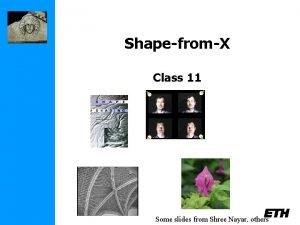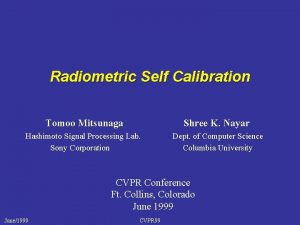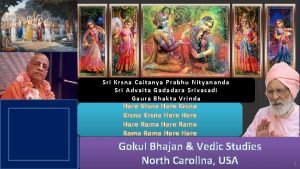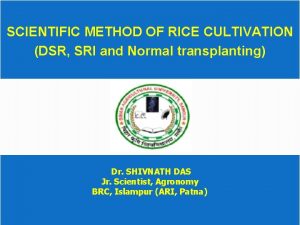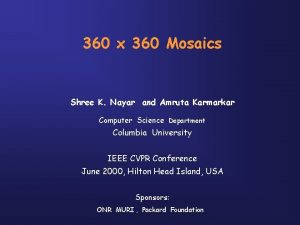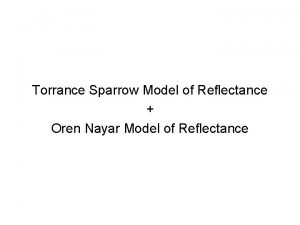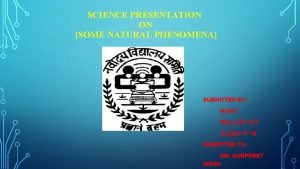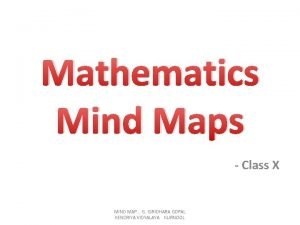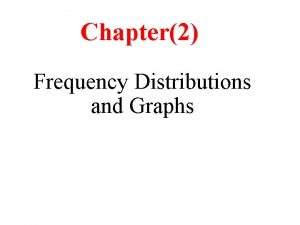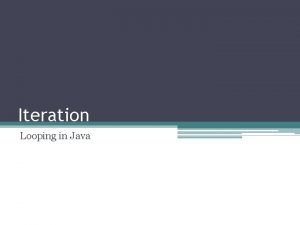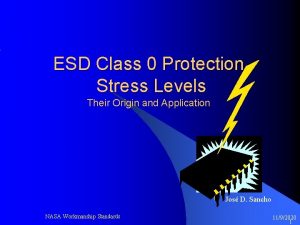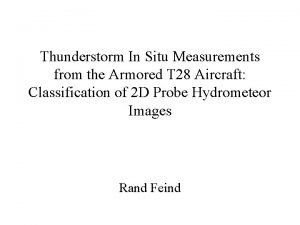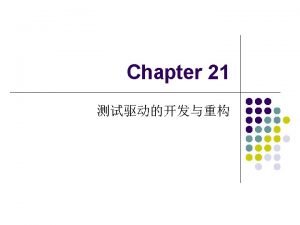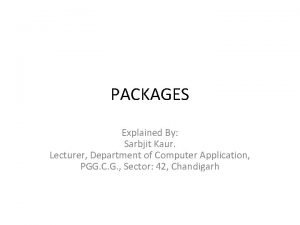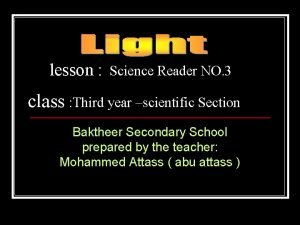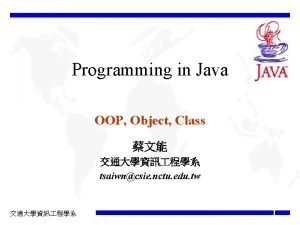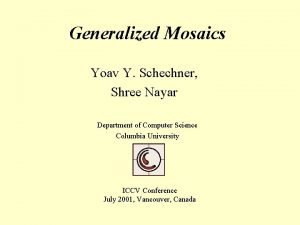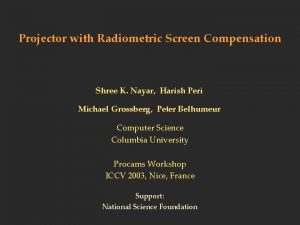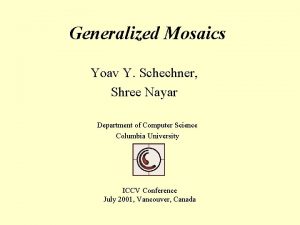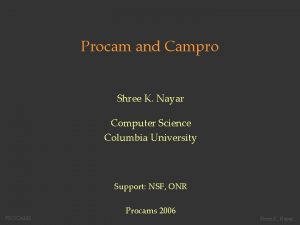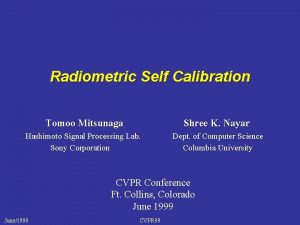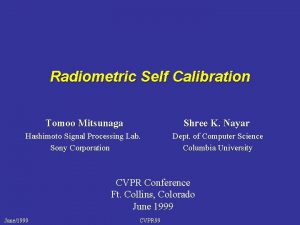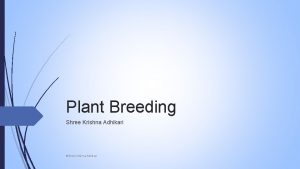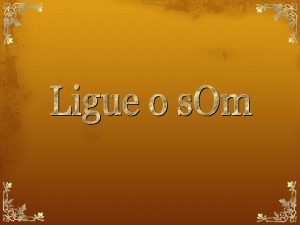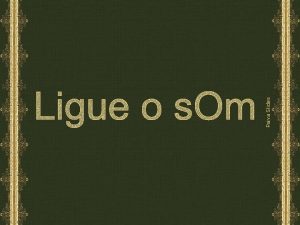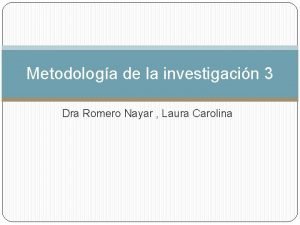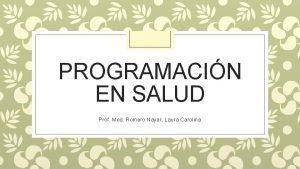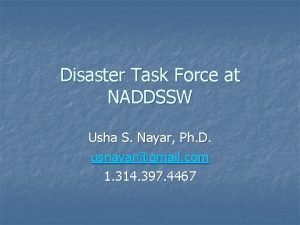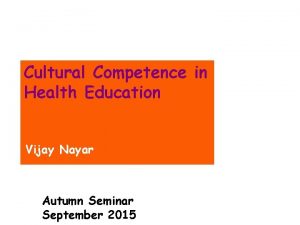ShapefromX Class 11 Some slides from Shree Nayar










































- Slides: 42

Shape-from-X Class 11 Some slides from Shree Nayar. others

3 D photography course schedule (tentative) Lecture Exercise Introduction - Oct. 3 Geometry & Camera model Camera calibration Oct. 10 Single View Metrology Measuring in images Oct. 17 Feature Tracking/matching Correspondence computation Sept 26 (Friedrich Fraundorfer) Oct. 24 Epipolar Geometry F-matrix computation Oct. 31 Shape-from-Silhouettes Visual-hull computation (Li Guan) Nov. 7 Stereo matching Project proposals Nov. 14 Structured light and active range sensing Papers Nov. 21 Structure from motion Papers Nov. 28 Multi-view geometry and self-calibration Papers Dec. 5 Shape-from-X Papers Dec. 12 3 D modeling and registration Papers Dec. 19 Appearance modeling and image-based rendering Final project presentations

Shape-from-X • X =Shading • X =Multiple Light Sources (photometric stereo) • X =Texture • X =Focus/Defocus • X =Specularities • X =Shadows • X =…

Shape from shading • • Shading as a cue for shape reconstruction What is the relation between intensity and shape? • Reflectance Map

Reflectance Map • • Relates image irradiance I(x, y) to surface orientation (p, q) for given source direction and surface reflectance Lambertian case: : source brightness : surface albedo (reflectance) : constant (optical system) Image irradiance: Let then

Reflectance Map • Lambertian case Reflectance Map (Lambertian) Iso-brightness contour cone of constant

Reflectance Map • Lambertian case iso-brightness contour Note: is maximum when

Shape from a Single Image? • • Given a single image of an object with known surface reflectance taken under a known light source, can we recover the shape of the object? Given R(p, q) ( (p. S, q. S) and surface reflectance) can we determine (p, q) uniquely for each image point? NO

Solution • Add more constraints • Shape-from-shading • Take more images • Photometric stereo

Stereographic Projection (p, q)-space (gradient space) (f, g)-space Problem (p, q) can be infinite when Redefine reflectance map as

Occluding Boundaries and are known The values on the occluding boundary can be used as the boundary condition for shape-from-shading

Image Irradiance Constraint • Image irradiance should match the reflectance map Minimize (minimize errors in image irradiance in the image)

Smoothness Constraint • Used to constrain shape-from-shading • Relates orientations (f, g) of neighboring surface points Minimize : surface orientation under stereographic projection (penalize rapid changes in surface orientation f and g over the image)

Shape-from-Shading • Find surface orientations (f, g) at all image points that minimize weight smoothness constraint Minimize image irradiance error

Results

Results

Solution • Add more constraints • Shape-from-shading • Take more images • Photometric stereo

Photometric Stereo

Photometric Stereo Lambertian case: Image irradiance: • We can write this in matrix form: : source brightness : surface albedo (reflectance) : constant (optical system)

Solving the Equations inverse

More than Three Light Sources • • Get better results by using more lights Least squares solution: • Solve for as before Moore-Penrose pseudo inverse

Color Images • The case of RGB images • get three sets of equations, one per color channel: • • Simple solution: first solve for using one channel Then substitute known into above equations to get • Or combine three channels and solve for

Computing light source directions • Trick: place a chrome sphere in the scene • the location of the highlight tells you the source direction

Specular Reflection - Recap • For a perfect mirror, light is reflected about N • • We see a highlight when Then is given as follows:

Computing the Light Source Direction Chrome sphere that has a highlight at position h in the image N H h r. N c C sphere in 3 D image plane • Can compute N by studying this figure • Hints: • • use this equation: can measure c, h, and r in the image

Depth from Normals V 2 V 1 N • Get a similar equation for V 2 • • Each normal gives us two linear constraints on z compute z values by solving a matrix equation

Limitations • Big problems • Doesn’t work for shiny things, semitranslucent things • Shadows, inter-reflections • Smaller problems • Camera and lights have to be distant • Calibration requirements • • measure light source directions, intensities camera response function

Trick for Handling Shadows • Weight each equation by the pixel brightness: • Gives weighted least-squares matrix equation: • Solve for as before

Original Images

Results - Shape Shallow reconstruction (effect of interreflections) Accurate reconstruction (after removing interreflections)

Results - Albedo No Shading Information

Original Images

Results - Shape

Results - Albedo

Results 1. 2. 3. 4. 5. Estimate light source directions Compute surface normals Compute albedo values Estimate depth from surface normals Relight the object (with original texture and uniform albedo)

Shape from texture • Obtain normals from texture element (or statistics) deformations, Examples from Angie Loh

Shape from texture • Obtain normals from texture element (or statistics) deformations, Examples from Angie Loh

Depth from focus • Sweep through focus settings • “most sharp” pixels correspond to depth (most high frequencies)

Depth from Defocus • More complicates, but needs less images • Compare relative sharpness between images

Shape from shadows S. Savarese, M. Andreetto, H. Rusmeier, F. Bernardini, P. Perona, “ 3 D Reconstruction by Shadow Carving: Theory and Practical Evaluation”, International Journal of Computer Vision (IJCV) , vol 71, no. 3, pp. 305 -336, March 2007.

Shape from specularities Toward a Theory of Shape from Specular Flow Y. Adato, Y. Vasilyev, O. Ben-Shahar, T. Zickler Proc. ICCV’ 07

Next class: 3 d modeling and registration
 Element examples
Element examples Shree nayar
Shree nayar Sri krsna caitanya prabhu nityananda
Sri krsna caitanya prabhu nityananda Sabour shree paddy
Sabour shree paddy Shree k
Shree k Annapurna mantra before eating
Annapurna mantra before eating Torrance sparrow
Torrance sparrow Vijay nayar
Vijay nayar Vibhu nayar ias
Vibhu nayar ias Sangeeta santra iit delhi
Sangeeta santra iit delhi Marketo outage
Marketo outage A small child slides down the four frictionless slides
A small child slides down the four frictionless slides Change in energy quick check
Change in energy quick check Sometimes you win some sometimes you lose some
Sometimes you win some sometimes you lose some They say it only takes a little faith to move a mountain
They say it only takes a little faith to move a mountain Countable and uncountable ice cream
Countable and uncountable ice cream What are some contact forces and some noncontact forces
What are some contact forces and some noncontact forces Some say the world will end in fire some say in ice
Some say the world will end in fire some say in ice Some say the world will end in fire some say in ice
Some say the world will end in fire some say in ice Some may trust in horses
Some may trust in horses Class 8 some natural phenomena ppt
Class 8 some natural phenomena ppt Mind map for trigonometry class 10
Mind map for trigonometry class 10 Have a class today
Have a class today Package mypackage class first class body
Package mypackage class first class body Difference between abstract class and concrete class
Difference between abstract class and concrete class Mode for grouped data
Mode for grouped data Class i vs class ii mhc
Class i vs class ii mhc Abstract concrete class relationship
Abstract concrete class relationship How to find class mark in grouped data
How to find class mark in grouped data Sd and sdelta
Sd and sdelta Discriminative stimulus psychology definition
Discriminative stimulus psychology definition 7 rights of medication administration in order
7 rights of medication administration in order Class maths student student1 class student string name
Class maths student student1 class student string name Unordered stem and leaf plot
Unordered stem and leaf plot In greenfoot, you can cast an actor class to a world class?
In greenfoot, you can cast an actor class to a world class? Static class loading and dynamic class loading
Static class loading and dynamic class loading Esd class 0 vs class 1
Esd class 0 vs class 1 Analysis model uml
Analysis model uml Class 2 class 3
Class 2 class 3 Extends testcase
Extends testcase Package mypackage class first class body
Package mypackage class first class body Class third class
Class third class Www.classpointapp
Www.classpointapp
